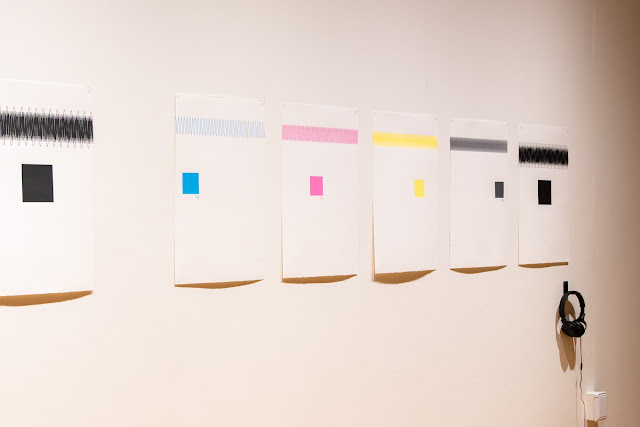Reflux /RePrint 2023 CMYKHZ (Or How We Thought Sounds Could Be Made) with Mathieu Léger June 1st until June 23
En collaboration sporadique depuis 1998, Jennifer Bélanger et Mathieu Léger se penchent sur l’espace angoissante du milieu des arts visuels, la vidéo, la performance, l’estampe, l’intervention furtive et l’installation. En tant qu’entité collaborative, le duo explore l’espace visuel et l’humour (parfois cynique) pour tenter de mettre en évidence des liens possible entre des occurrences quotidiennes disparates. Pour ce projet, la couleur et le son seront exploités par un protocole alambiqué qui tente de juxtaposer les médiums de l’estampe et l’art sonore.
Sporadically collaborating since 1998, Jennifer Bélanger and Mathieu Léger address the anxious space of the visual arts, video, performance, printmaking, furtive intervention, and installation. As a collaborative entity, the duo explores visual space and humour (sometimes cynical) in an attempt to highlight possible connections between disparate everyday occurrences. For this project, colour and sound will be exploited through a convoluted protocol that attempts to juxtapose the mediums of print and sound art.
CMYKHZ (Or How We Thought Sounds Could Be Made)
“We developed a prescriptive approach that could generate a protocol, produce an
algorithm that would help simplify creative decisions.” JB & ML
This print and sound based project was first developed by artists Jennifer Bélanger and
Mathieu Léger for exhibition during RE:FLUX 18, an experimental sound and music
festival presented by Galerie Sans Nom in Moncton, NB, Canada. CMYKHZ is a series
of 11 large format screen prints (edition of 5 each), 4 digital prints and two sound files
(which require headphones). The work was presented for RE:PRINT 2023 at Atelier
d’estampe Imago, the print studio’s partnership with RE:FLUX Festival. The following is
the sequence the artists used for determining the creative elements for the works:
1. Choose a vinyl record from the year of birth.
Jennifer: Brian Eno, Taking Tiger Mountain (By Strategy), 1974.
Mathieu: One Size Fits All, Frank Zappa and the Mothers of Invention, 1975.
2. Flip a Canadian 25¢ coin to determine whether the front or back of the sleeve will be
used.
Jennifer: Heads.
Mathieu: Tails.
3. Scan the record sleeve according to the previous choice.
4. Play dice to determine the coordinates of one pixel in the digital image to be used as
the initial colour source.
5. Sample the colour at this coordinate and separate the colours in a four-colour
process/CMYK (Cyan, Magenta, Yellow, Black—method for commercial printers).
6. Once the colours have been divided, the value (in percent) of each colour is
translated into sound frequency (hertz).
7. Each colour is screen-printed separately, juxtaposed with the sine wave of its
frequency (multiplied by rule #8, see below). The initial colour is printed with the
accumulation of all frequencies. These serigraphs are printed in an edition of four, plus
two artists' proofs and one studio proof.
8. The initial colour value is multiplied by its letter value (C = 3, M = 13, Y = 25, K = 11—
depending on their place in the alphabet) to determine the frequency of the sine wave.
9. The final value determines a sound frequency which is generated as a tone (pure
sine wave).
10. The five notes (including an average of all four) are juxtaposed to create a set of
sounds that shift, provided on the headphones for each set of prints.








Comments
Post a Comment